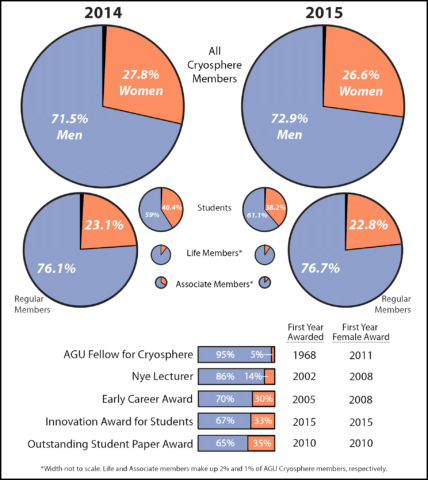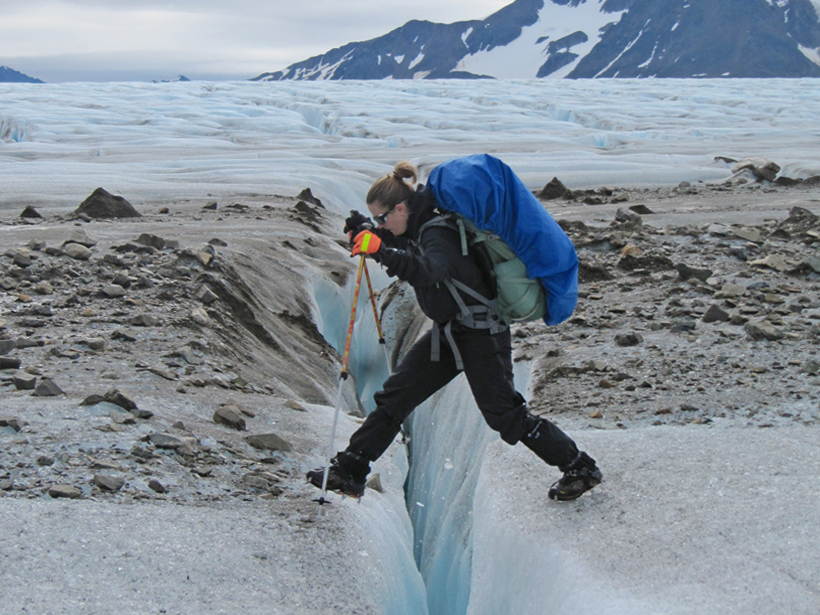If we value diversity and believe our discipline will be at its best when every student has equal opportunity, then we must do more than talk; we must act.
The following question was raised during the February 2016 meeting of the American Geophysical Union’s (AGU) Cryosphere focus group Executive Committee: Do awards given by the focus group reflect the diversity in our field?
This deceptively straightforward question is hard to answer. Cryosphere awards are not balanced—there is less diversity in our more senior awards—but to what extent is imbalance expected given that women and minorities are underrepresented across science, technology, engineering, and math (STEM) fields [see National Center for Science and Engineering Statistics, 2015; Blickenstaff, 2005; Williams et al., 2014]?
The Cryosphere Executive Committee’s inability to answer its own question demonstrates that even where individuals are concerned about diversity, knowledge is lacking. If we value diversity and believe our discipline will be at its best when every student has equal opportunity, then we must do more than talk; we must act. Awareness and data collection are part of ensuring a diverse field now and in the future.
A Hot Topic in a Cold Field
In March 2016, diversity research within the cryosphere community was attacked, causing concern beyond ensuring a fair awards system. A message to Cryolist, a major cryospheric sciences listserv, expressed the opinion that an advertised study of sexual harassment in Earth Science was likely a “spoof” and not appropriate subject for study. Yet a study on scientific fieldwork found that 64% of respondents experienced sexual harassment [Clancy et al., 2014].
A paper by Carey et al. [2016], drawing attention to the gendered nature of cryosphere knowledge production and the lack of diversity in knowledge transfer, sparked a frenzy in the blogosphere and was criticized as being unserious and not worth the tax dollars spent on it.
Were these reactions aberrations or typical of the cryospheric science community? We cannot answer this question; however, we can say that AGU’s Cryosphere Executive Committee is committed to diversity within our field and to quantitative assessment of demographic data.
Focus Group by the Numbers

AGU started tracking sex and age data for our group in 2014. AGU does not track race or ethnicity as attributes are not constant across the international membership. So our goal to study diversity is limited by available data to sex.
Figure 1 summarizes what we know about the Cryosphere focus group. The focus group currently comprises roughly 2% of AGU membership. Approximately 1% of members declined to answer. Our average age was 42 in both 2014 and 2015. Students, the most diverse cohort of membership, make up about 27% of the focus group. Regular members, professionals engaged in Earth and space sciences, make up about 70% of the focus group. Associate and life members make up about 1% and 2%, respectively. We clearly see less gender balance in later career stages.
Breakdown of Awards
The Cryosphere focus group oversees three exclusive honors: the Early Career Award, the Innovation Award for Students, and the Nye Lecture, which honors an outstanding cryospheric scientist and his or her ability to present exciting science. It also helps select Union-wide honors, including AGU Fellowships for cryosphere studies, and Outstanding Student Paper Awards for cryosphere research presented at conferences.
These awards cover the entire academic career from student to senior researcher. Figure 1 reports the percentage of male and female awardees, the year of the first award, and the year it was first awarded to a female. Our data show women are slightly underrepresented (~4%) in student awards and slightly overrepresented (~7%) in the Early Career Award compared with membership numbers. However, at this time, with only 2 years of membership data, we feel these awards are likely representative.
This time series suggests that our Nye Lecturer award reflects past diversity while our Fellows awards exhibit some bias against awards to women.
As with our membership, award diversity decreases in later career stages. This may be a generational effect; fewer junior women in the past leads to fewer senior women today. For perspective, we looked to longer time series of data outside of AGU.
The longest history comes from Hulbe et al. [2010], who documented the sex of first and second authors in International Glaciological Society journals from 1948 to 2010. Female authors comprised about 5% of authors from the 1950s through the 1980s, 13% in the 1990s, 16% in the 2000s, and roughly 20% by the end of the study.
Thus, if the women who were publishing in the 1990s are our more advanced career female scientists today, we should expect to see their 13% representation mirrored in senior roles. This time series suggests that our Nye Lecturer award reflects past diversity while our Fellows awards exhibit some bias against awards to women.
A Broader View
We look to the percentage of research awards made to female principal investigators (PIs) and females serving in editorial positions for additional context. PIs of NASA Cryospheric Science grants, from 2007 to 2014, were 17% female (according to the NASA Solicitations and Proposal Integrated Review and Evaluation System). The U.S. National Science Foundation Division of Polar Programs made 18% of its awards to female PIs in the period 1997–1999 and 24% during the 4th International Polar Year (2007–2009 [National Research Council, 2012]).
Although no cryosphere-specific data were available, the European Research Council’s Working Group on Gender Balance reports that in the period 2007–2013, 20% of its Physical and Engineering Sciences Starting/Consolidator grants and 7% of its advanced grants (from 2008 to 2013) were to women.
We also selected three journals, inclusive to cryosphere, that represent the broadness of our field: The Cryosphere, Journal of Glaciology, and Permafrost and Periglacial Processes. In March 2016 all chief or cochief editors were male, and the editorial boards contained 9%, 18%, and 0% females, respectively.
Although direct comparisons among the various metrics are not possible, they illustrate the environment in which women work and in which they obtain (or fail to obtain) the support and experience needed to progress in their careers. Overall, these broader metrics are similar to those reported by Hulbe et al. [2010], supporting our expectation that more women should be earning AGU Fellowships for cryospheric studies.
Into the Future
Back to the overarching question. Do AGU Cryosphere awards reflect the currently available diversity statistics?
The Cryosphere focus group will continue to track diversity on a biennial basis.
Our answer is yes, except in the Fellows category. We have actively pursued a diverse set of Fellows applications and expect this category to improve.
Of course, the low representation overall reflects the imbalance of men and women in our field. Women are underrepresented, and inequality escalates with career tenure. Although we do not currently have data, we would expect this trend for minorities as well. Unless bias within the STEM fields is addressed, this imbalance is unlikely to change.
The Cryosphere focus group will continue to track diversity on a biennial basis. We strive to make cryospheric sciences a field with equal opportunity for all who enter so that we have the best minds available to address scientific questions relevant to our global society.
We encourage other focus groups to follow our lead, and we look forward to more studies and research aimed at understanding and improving diversity within cryospheric science, AGU, and STEM fields.
References
Blickenstaff, J. C. (2005), Women and science careers: Leaky pipeline or gender filter?, Gender Educ., 17, 369–386, doi:10.1080/09540250500145072.
Carey, M., M. Jackson, A. Antonello, and J. Rushing (2016), Glaciers, gender, and science: A feminist glaciology framework for global environmental change research, Prog. Hum. Geogr., doi:10.1177/0309132515623368, in press.
Clancy, K. B. H., R. G. Nelson, J. N. Rutherford, and K. Hinde (2014), Survey of Academic Field Experiences (SAFE): Trainees report harassment and assault, PLOS ONE, 9, e102172, doi:10.1371/journal.pone.0102172.
Hulbe, C. L., W. Wang, and S. Ommanney (2010), Women in glaciology, a historical perspective, J. Glaciol., 56(200): 944–964, doi:10.3189/002214311796406202.
National Center for Science and Engineering Statistics (2015), Women, minorities, and persons with disabilities in science and engineering: 2015, Spec. Rep. NSF 15-311, Natl. Sci. Found., Arlington, Va. [Available at https://www.nsf.gov/statistics/wmpd/.]
National Research Council (2012), Lessons and Legacies of the International Polar Years 2007–2008, Natl. Acad. Press, Washington, D. C.
Williams, J. C., K. W. Phillips, and E. V. Hall (2014), Double jeopardy? Gender bias against women of color in science, report, WorkLifeLaw, Univ. of Calif. Hastings Coll. of the Law, San Francisco. [Available at https://www.uchastings.edu/news/articles/2015/01/double-jeopardy-report.pdf.]
—Lora Koenig, National Snow and Ice Data Center, University of Colorado, Boulder; email: [email protected]; Christina Hulbe, School of Surveying, University of Otago, Dunedin, New Zealand; Robin Bell, Lamont-Doherty Earth Observatory, Columbia University, Palisades, N.Y.; and Derrick Lampkin, Department of Atmospheric and Ocean Science, University of Maryland, College Park
Editor’s Note: Lora Koenig is the secretary of AGU’s Cryosphere focus group, Robin Bell is president of the focus group, and Derrick Lampkin is the chairman of the focus group’s outreach and diversity efforts.
Citation: Koenig, L., C. Hulbe, R. Bell, and D. Lampkin (2016), Gender diversity in cryosphere science and awards, Eos, 97, doi:10.1029/2016EO049577. Published on 5 April 2016.
Text © 2016. The authors. CC BY-NC 3.0
Except where otherwise noted, images are subject to copyright. Any reuse without express permission from the copyright owner is prohibited.

